Theory of Jet Engines (Well Sort Of)
-
Can you explain how various jet engines work, including the turbojet, turbofan, turboprop, and turboshaft? In particular, what is the difference between a turbojet and a turbofan and which is more efficient?
-
The term "jet engine" is often used as a generic name for a variety of engines, including the turbojet, turbofan, turboprop, and ramjet. These engines all operate by the same basic principles, but each has its own distinct advantages and disadvantages. All jet engines operate by forcing incoming air into a tube where the air is compressed, mixed with fuel, burned, and exhausted at high speed to generate thrust.
The key to making a jet engine work is the compression of the incoming air. If uncompressed, the air-fuel mixture won't burn and the engine can't generate any thrust. Most members of the jet family employ a section of compressors, consisting of rotating blades, that slow the incoming air to create a high pressure. This compressed air is then forced into a combustion section where it is mixed with fuel and burned. As the high-pressure gases are exhausted, they are passed through a turbine section consisting of more rotating blades. In this region, the exhausting gases turn the turbine blades which are connected by a shaft to the compressor blades at the front of the engine. Thus, the exhaust turns the turbines which turn the compressors to bring in more air and keep the engine going. The combustion gases then continue to expand out through the nozzle creating a forward thrust. The above explanation describes a simple turbojet, as illustrated below.
Diagram of an axial-flow turbojet
The turbojet (and the turbofan) can also be fitted with an afterburner. An afterburner is simply a long tube placed in between the turbine and the nozzle in which additional fuel is added and burned to provide a significant boost in thrust. However, afterburners greatly increase fuel consumption, so aircraft can only use them for brief periods.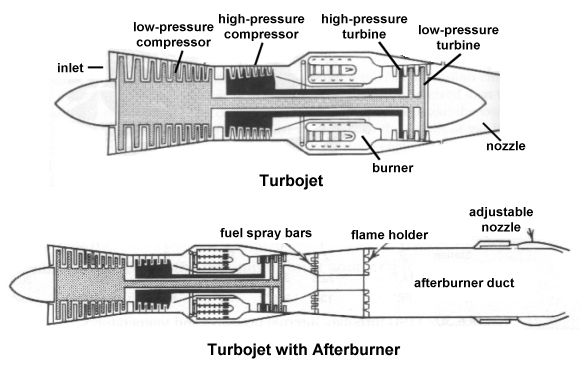
-
A further variation on the turbojet is the turbofan. Although most components remain the same, the turbofan introduces a fan section in front of the compressors. The fan, another rotating series of blades, is also driven by the turbine, but its primary purpose is to force a large volume of air through outer ducts that go around the the engine core. Although this "bypassed" air flow travels at much lower speeds, the large mass of air that is accelerated by the fan produces a significant thrust (in addition to that created by the turbojet core) without burning any additional fuel. Thus, the turbofan is much more fuel efficient than the turbojet. In addition, the low-speed air helps to cushion the noise of the jet core making the engine much quieter.
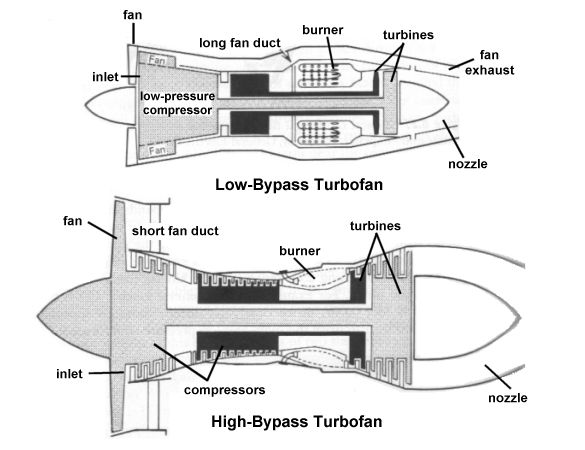 Comparison of a low-bypass turbofan with long ducts and a high-bypass turbofan with short ducts
Comparison of a low-bypass turbofan with long ducts and a high-bypass turbofan with short ducts
Turbofans are typically broken into one of two categories--low-bypass ratio and high-bypass ratio--as illustrated above. The bypass ratio refers to the ratio of incoming air that passes through the fan ducts compared to the incoming air passing through the jet core. In a low-bypass turbofan, only a small amount of air passes through the fan ducts and the fan is of very small diameter. The fan in a high-bypass turbofan is much larger to force a large volume of air through the ducts. The low-bypass turbofan is more compact, but the high-bypass turbofan can produce much greater thrust, is more fuel efficient, and is much quieter. -
Its so long leh, need to dig up abit. For beginner basics, go search www.howstuffworks.com or even better input those keywords into yahoo search engine. Its all in simpler layman terms.
But if you really want to go into the exact specific details, like what I do to pass my exams, then I recommend you the below textbooks:
Fluid Mechanics, 4th Edition, by J.F Douglas, J.M Gasiorek and J.A Swaffield published by Prentice Hall.
Heat Transfer, A Practical Approach, 2nd Edition, by Yunus A Cengel. published by Mcgraw Hill.
-
A concept similar to the turbofan is the turboprop. However, instead of the turbine driving a ducted fan, it drives a completely external propeller. Turboprops are commonly used on commuter aircraft and long-range planes that require great endurance like the P-3 Orion and Tu-95.
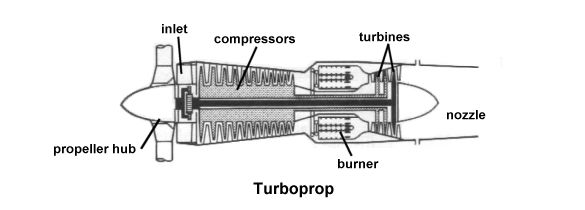
Schematic of a turboprop engine
The turboprop is attractive in these applications because of its high fuel efficiency, even greater than the turbofan. However, the noise and vibration produced by the propeller is a significant drawback, and the turboprop is limited to subsonic flight only. In a typical turboprop, the jet core produces about 15% of the thrust while the propeller generates the remaining 85%. -
that's why i added (well sort of)Originally posted by ditzy:Its so long leh, need to dig up abit. For beginner basics, go search www.howstuffworks.com or even better input those keywords into yahoo search engine. Its all in simpler layman terms.
But if you really want to go into the exact specific details, like what I do to pass my exams, then I recommend you the below textbooks:
Fluid Mechanics, 4th Edition, by J.F Douglas, J.M Gasiorek and J.A Swaffield published by Prentice Hall.
Heat Transfer, A Practical Approach, 2nd Edition, by Yunus A Cengel.

-
Another noteworthy variation on the turbojet is the ramjet. The idea behind this type of engine is to remove all the rotary components of the engine (i.e. fans, compressors, and turbines) and allow the motion of the engine itself to compress incoming air for combustion.
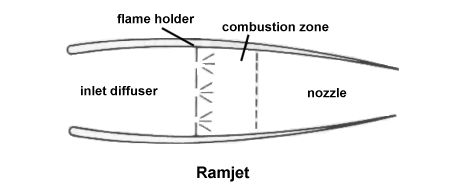
Simple schematic of a ramjet
However, the price of this simplicity is that the ramjet can only produce thrust when it is already in motion. Instead of using a compressor to draw in air and compress it for combustion, the ramjet relies on the motion of the aircraft to ram air into the engine at high enough speed that it is already sufficiently compressed for combustion to occur. Since ramjets typically cannot function until reaching about 300 mph (485 km/h) at sea level, they have been rarely used on manned aircraft. However, the ramjet is more fuel efficient than turbojets or turbofans starting at about Mach 3 making them very attractive for use on missiles. Such missiles are typically launched using rocket motors that accelerate the vehicle to high-subsonic or low-supersonic speeds where the ramjet is engaged. -
Finally, let us talk briefly about the turboshaft, a version of the jet engine that powers nearly every helicopter built today. As the below image illustrates, the turboshaft utilizes many of the same components as a turbojet.
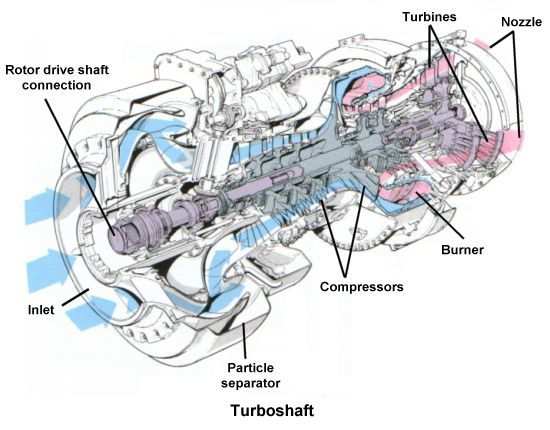
Schematic of a turboshaft engine
Air is drawn in through an inlet, compressed by low- and high-pressure compressor blades, mixed with fuel and burned in a combustion chamber, passed through turbine blades, and exhausted through a nozzle. The key difference between the turboshaft and previously discussed engines is that the turbine not only drives the compressors, but the shaft is also connected to a gear box that drives a helicopter's rotor blades. Although the engine shaft rotates about the horizontal, the gear box contains a sequence of gears that transform that motion to a rotation about the vertical axis as required by a helicopter main rotor. Helicopters also typically operate at much lower altitudes than aircraft where dust, sand, and other debris can easily be sucked into the engine. To address this problem, most turboshaft engines are equipped with a particle separator that filters out and expels the unwanted dust before the air flow reaches the compressor.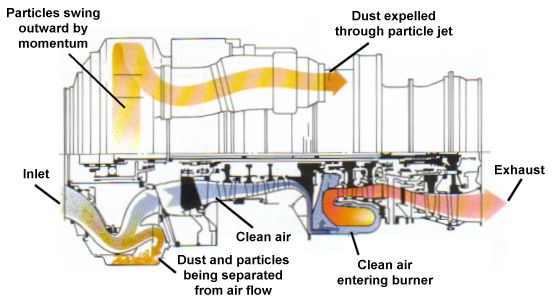
-
Originally posted by ditzy:
http://travel.howstuffworks.com/turbine6.htm
Its so long leh, need to dig up abit. For beginner basics, go search www.howstuffworks.com or even better input those keywords into yahoo search engine. Its all in simpler layman terms. -
While the turboprop is still popular on aircraft where low fuel consumption is vital, nearly all aircraft today employ some version of the turbofan, usually high-bypass turbofans. The high thrust, low fuel consumption, and low noise levels of these engines make them well-suited to both military and commercial applications. Today, about the only use for turbojets and ramjets is in missiles. Air-breathing, long-range, subsonic missiles like the Tomahawk use turbojets since these are small, relatively low-cost systems that provide much greater range than is possible with a rocket of comparable size. Ramjets find applications on air-breathing, long-range, supersonic missiles for similar reasons. Turboshafts, of course, have displaced the piston engine as the primary powerplant used on helicopters.
-
i'm not seeking an answer, i don't require it.Originally posted by nukewatch:http://travel.howstuffworks.com/turbine6.htm -
Question : I saw a comment on your site saying that the C-130 is powered by jet engines. Correct me if I am wrong, but I flew on a lot of C-130s and none had jet powered engines, they all had propellers.
Answer : I understand your confusion. However, the C-130 actually is powered by jet engines. They are a class of jet engines called turboprops in which a small jet engine is used to turn a large propeller. You can learn more about how these engines work in another question we answered about the different kinds of jet engines.
It is a common misconception that if a plane has propellers, then it cannot be a "jet." However, this is not so. The turboprops used on planes like the C-130, P-3 Orion, and many commuter planes such as the ATR-42 do indeed use propellers to generate thrust, but the basic technology that turns those propellers is based on the turbojet. In more general terms, a turbojet is a gas turbine engine, and that same gas turbine cycle is used to power a turboprop as well as a turbofan. A turbofan is just like a turboprop except that some of the power generated by the gas turbine core is used to turn a series of ducted fan blades that generate additional thrust.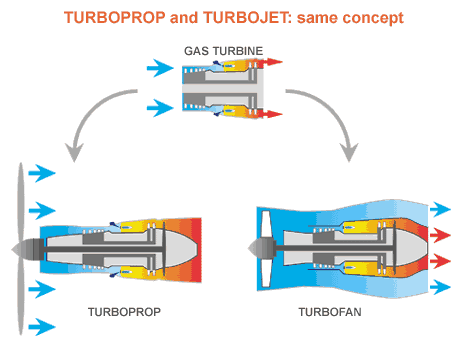
A similar class of engines that is just starting to be used on production aircraft is the propfan. Although the propfan also utilizes a gas turbine core, the power generated by the core is used to turn a series of unducted fan blades rather than propellers. These fan blades convert the power generated by the engine into thrust to push the aircraft forward.
The key point to remember is that both the turboprop and the propfan are classified as "jets" since a jet engine is at the heart of the system. This is not true in the case of other propeller-driven aircraft, such as those of WWII or most modern-day light general aviation planes. These craft are powered by piston engines, a much different technology that is more akin to how an automobile engine works -
Heres a little known fact about engines and turbines. They are designed to run at high temperatures. Reason being that they are designed according to the Carnot heat engine principle. The highest effieciencies are obtained when the they lose less heat than they are generating when in operation.

-
=Danger=
Info overload.
Abort, cancel, or reboot?
Press any key when ready. -
Reducing Landing Distance
Thrust reversing is a process used to help reduce the distance a plane travels during landing. As an aircraft touches down on a runway, it has a certain amount of kinetic energy that gives it forward momentum. This energy is proportional to the weight of the aircraft and the square of its speed. As a result, the heavier a plane is and the faster it is traveling as it lands, the more force it takes to bring the vehicle to a stop.
Stopping an aircraft during the early days of aviation was not all that difficult. Even through World War II, most aircraft were relatively small and landed at low enough speeds that simple brakes, comparable to those on an automobile, were sufficient to stop a plane in a reasonable distance. It is true that the brakes used in aviation were generally more advanced than those used in the auto industry--disk brakes were first used on an airplane around 1910 while they did not become common on cars until the 1950s--but the basic concept was simple enough.
Wheel brakes used on a typical light airplane
However, the advent of the jet engine ushered in a new era of much larger and faster aircraft for both the military and airline operations. Though wheel brakes were still used on these aircraft, they proved unable to bring modern planes to a stop without incredibly long runways. This behavior made it necessary to develop new mechanisms to create drag that overcomes the kinetic energy of a landing aircraft and reduces the landing roll. The concepts for doing so generally fall into two categories, aerodynamic devices and propulsive devices.
The two primary aerodynamic devices that have been used to increase drag on a plane during landing are control surfaces and parachutes. Some control surfaces, like the speed brake shown on the Su-27 below, are designed primarily for this purpose.
Speed brake on the Su-27
Other devices serve multiple purposes depending on how they are used during the course of a flight. Most commercial airliners are equipped with wing spoilers that are used to make banking turns. These devices are used during flight when the spoiler on one wing is deployed causing the plane to go into a bank. However, the devices can also be deflected on both wings simultaneously during landing. This use of spoilers creates an equal amount of drag on both sides of the plane that helps to slow the vehicle down and reduce the landing roll. A similar device is the drag rudder used on planes like the B-2 Spirit. Drag rudders are located near the wingtips and are also used primarily to help the plane turn during flight. Deflecting the rudders together during landing, however, creates aerodynamic drag to slow the plane down.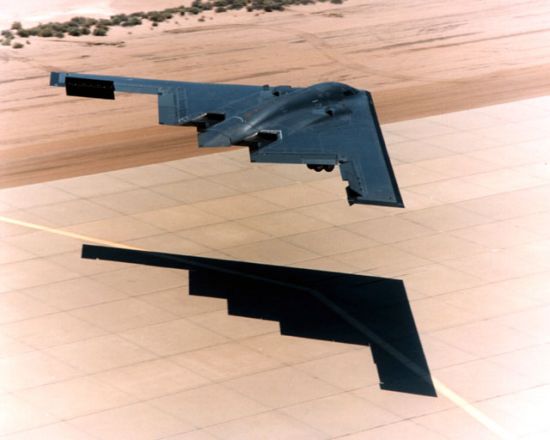
Drag rudders on the B-2 -
Another aerodynamic device that is less commonly used is the drag parachute. These parachutes are typically used only on military aircraft, although some Russian commercial airliners have actually used them as well. The Space Shuttle is also equipped with a parachute. During landing, one or more parachutes are deployed from a compartment in the aft end of an aircraft to increase the drag of the vehicle and provide additional stopping force. The primary disadvantage of this approach is that the parachute must be repackaged aboard the plane before the aircraft can take off again on its next flight.
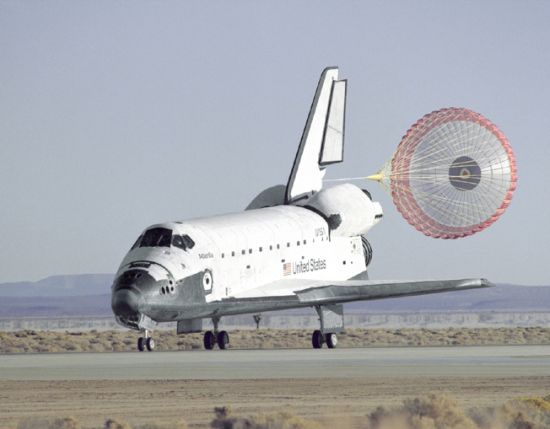
Braking parachute used on the Space Shuttle
In addition to brakes and aerodynamic devices, an airplane's engines can also be used to help bring the vehicle to a stop. Many aircraft that generate thrust using propellers, whether they be powered by piston or turboprop engines, use variable pitch propeller blades. These blades can be rotated to different positions during flight to maximize their efficiency in producing thrust. In addition, the blades can be rotated to a position that creates high drag during landing to slow the aircraft.
A comparable device on jet-powered planes is called the thrust reverser. One common misconception about thrust reversing is that the engine itself does not run in reverse. In other words, air does not come in through the nozzle of the engine and be exhausted through the inlet to "reverse" the thrust. The engine itself still operates in the same manner, but the thrust it generates is redirected to produce drag. A number of different ways exist to reverse the thrust of both turbojet and turbofan engines, but they generally fall into two categories. These two methods are called cascades and clam shells, both of which are shown below on a conceptual schematic of a turbofan engine.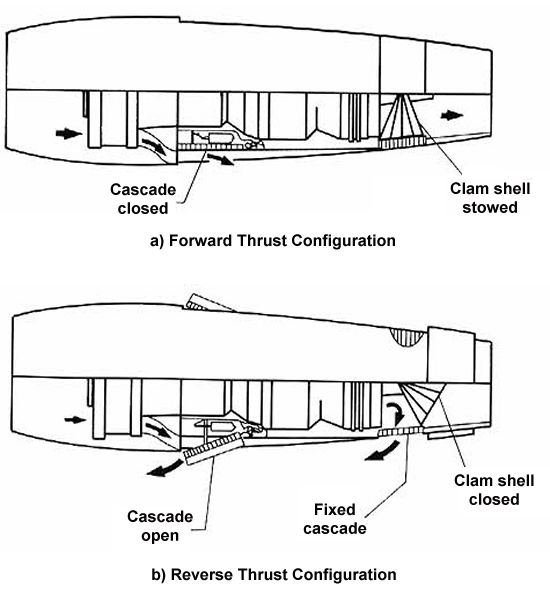
Thrust reversers on a turbofan engine
A cascade is basically a series of vanes that turns the air and directs it in a new direction. The cascade is built into the side of the engine nacelle and covered by a hinging or sliding door. When the door opens, it blocks off the flow of air through the engine and instead turns that air outward and forward to reverse its direction. This action turns the thrust into drag that resists the forward motion of the aircraft.
Cascades can be used both on the cool bypass air passing through the fan section of a turbofan and on the hot exhaust gases passing through the nozzle of a turbojet or turbofan. They are quite common on commercial airliners like the Boeing 737, DC-8, and L-1011 since cascades can be easily integrated into conventional engine nacelles. Cascades are also used on large military transport planes like the C-17 Globemaster III.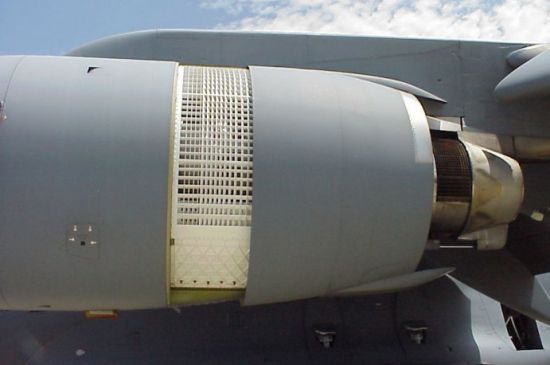
Cascade thrust reverser on the C-17 -
While cascades are more often used to redirect the flow through the bypass fan, a clam shell reverses the flow through the nozzle of a turbofan or turbojet engine. In this design, the outer nozzle wall is broken into two pieces. These pieces split apart and rotate backward to form a cone that deflects the airflow outward, as illustrated below.
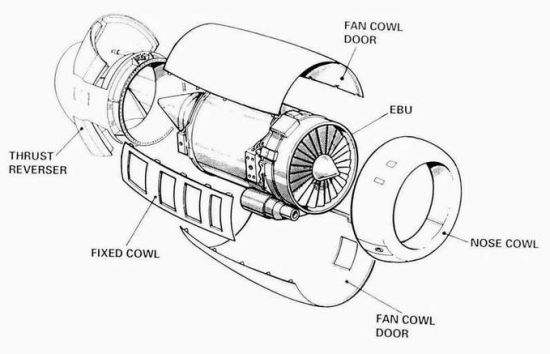
Clam shell thrust reverser on a turbofan engine
Clam shell thrust reversing nozzles are also frequently used on both military and civilian aircraft. An example of a common design is that used on the DC-9 pictured below.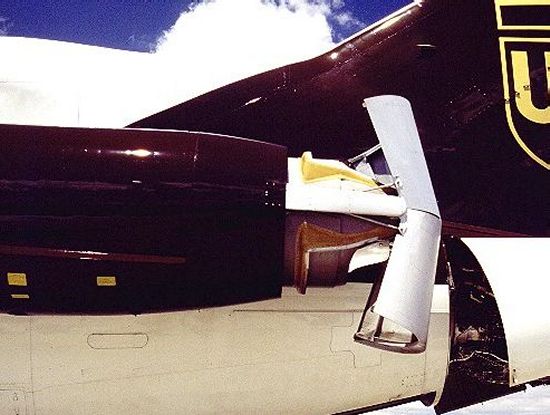
Clam shell thrust reverser on the DC-9
Most modern jet-powered airplanes equipped with thrust reversers use cascades, clam shells, or a mixture of the two. The exact configuration varies depending on the engine design, the placement of the engine, and the bypass ratio. Thrust reversers are usually only operated during landing. They are deployed just after touchdown and remain in operation until some minimum speed is reached. Below this speed, the danger of the hot exhaust gases being reingested, or pulled back into the engine, is too high. Both the exhaust gas and foreign debris could damage the engine, so the thrust reversers are closed at low speeds to prevent ingestion. On most aircraft, the thrust reversers are retracted once the plane slows below 70 mph (115 km/h). -
Question: Is there any possibility to reverse the direction of an aircraft with the help of thrust reversing
Answer: One could never use such devices to fly backward since neither fixed wing aircraft nor their engines are designed to do so in the first place. Many problems would be encountered when attempting to fly in reverse, some of which are wing stall, engine flameout, and loss of control surface responsiveness.
Nevertheless, one interesting sidebar concerns research in using thrust reversers during flight to improve maneuverability. The idea was originally proposed by the US Navy as a way to better control the glide path during landings aboard aircraft carriers. Navy pilots of the 1950s were finding that the engines on their early jet aircraft were too slow in responding to the subtle changes in throttle required during carrier landings. It was hoped that an in-flight thrust reversing system would provide a faster response while maintaining the same engine revolutions per minute. NASA took charge of the study and conducted flight tests using a modified F-94C Starfire.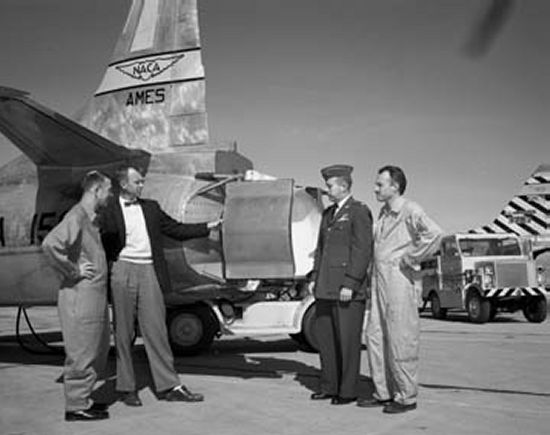
Thrust reverser used on the F-94C during NASA experiments
Additional tests were conducted for the Air Force, airline pilots, and the Federal Aviation Administration using F-104 Starfighter, CV-990, and DC-8 test planes. This research continued through the mid-1970s and proved that thrust reversers could be used to provide a very steep and rapid descent to follow a desired flight path.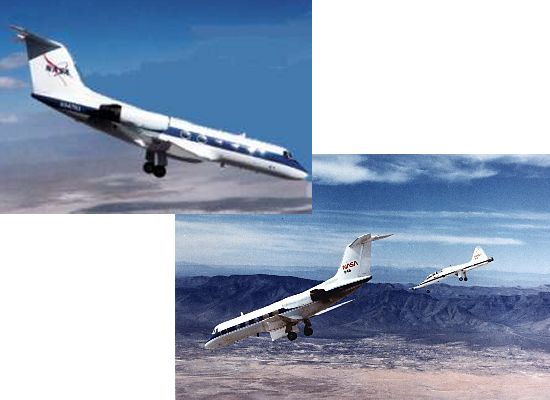
NASA Shuttle Training Aircraft using thrust reversers
The only planes that appear to have ever used this technique operationally are NASA's Shuttle Training Aircraft (STA). These planes are Gulfstream II business jets modified to simulate the landing characteristics of the Space Shuttle and used to train astronauts. In order to approximate the high descent rate of the Shuttle, the Gulfstreams pitch nose down into a 20° glideslope with the main landing gear down and thrust reversers deployed. This configuration creates very high drag and gives the STA a rate of descent around 14,000 ft/min (4,265 m/min) while maintaining a 300 knot dive. A Shuttle astronaut will have flown at least 500 of these simulated landings aboard the STA by the time he or she makes the first trip into space. -
wow.. kopiosatu, u know so much bout jet engines and stuffs like tat.
can i ask u in future regarding jet engines and stuffs related to flying bcos now i am studying aerospace in poly?hehe
-
I dunno much... all these are from the web.Originally posted by monkeybusiness:wow.. kopiosatu, u know so much bout jet engines and stuffs like tat.
can i ask u in future regarding jet engines and stuffs related to flying bcos now i am studying aerospace in poly?hehe
If you're really interested, you should go read up more! -
Taken from http://www.aerospaceweb.org
-
yeah.. the web provides nearly everything now. there is almost nothing you cannot find. note the 'almost'.

-
I've always wondered what they teach in there...Originally posted by monkeybusiness:wow.. kopiosatu, u know so much bout jet engines and stuffs like tat.
can i ask u in future regarding jet engines and stuffs related to flying bcos now i am studying aerospace in poly?hehe
do you get any hands on practice? like lockwiring?
And do you all have to know things like ehhhh...
why is biobor used in fuel, what's the difference between the fuel... what are the name of the tools, what are the name of the fasteners used... why are do we have to check for nicks & cracks, what is debonding? -
what u mean u dunno muchOriginally posted by kopiosatu:I dunno much... all these are from the web.
If you're really interested, you should go read up more! -
learn to be humble.Originally posted by the.raven:what u mean u dunno much